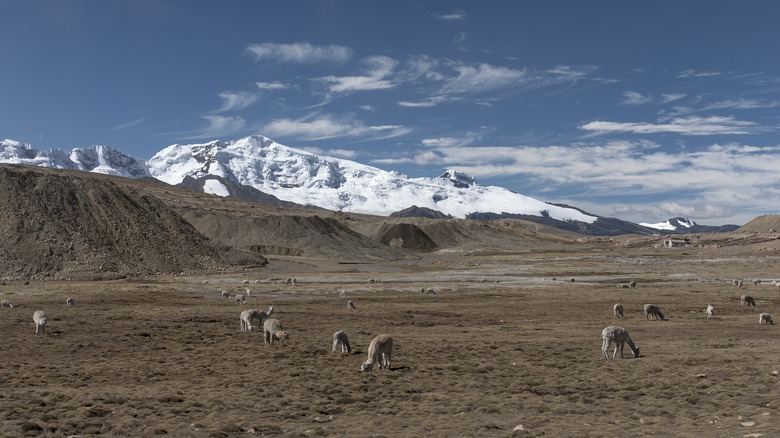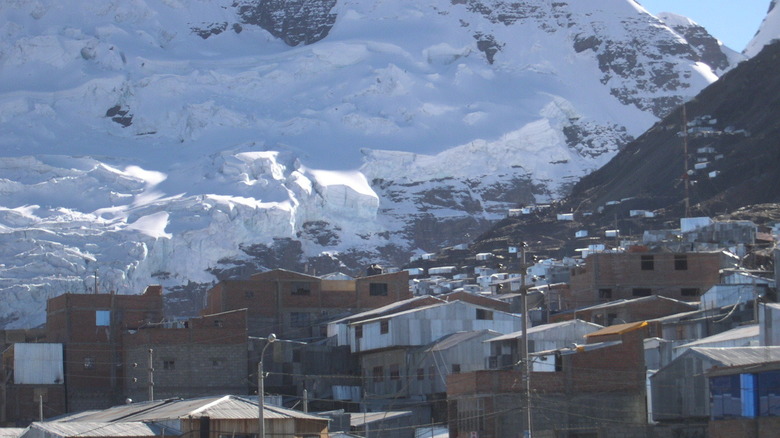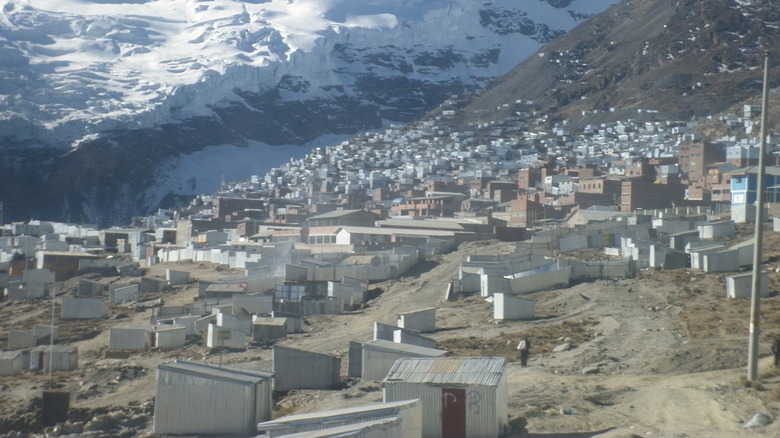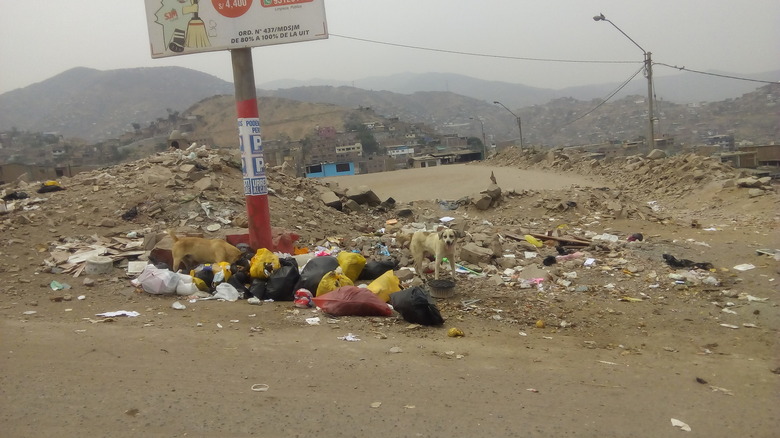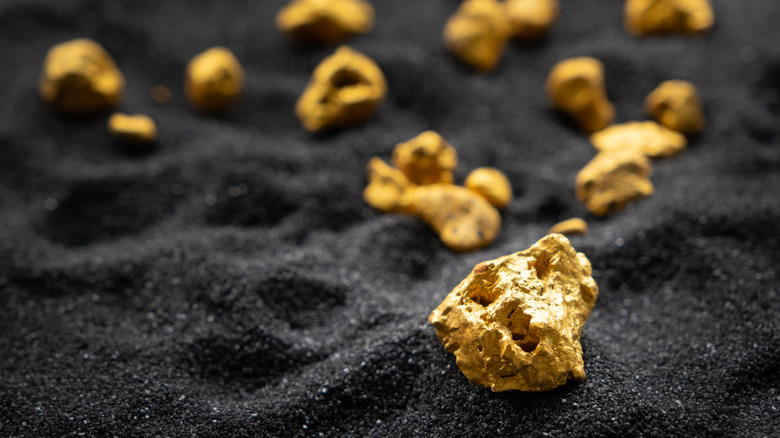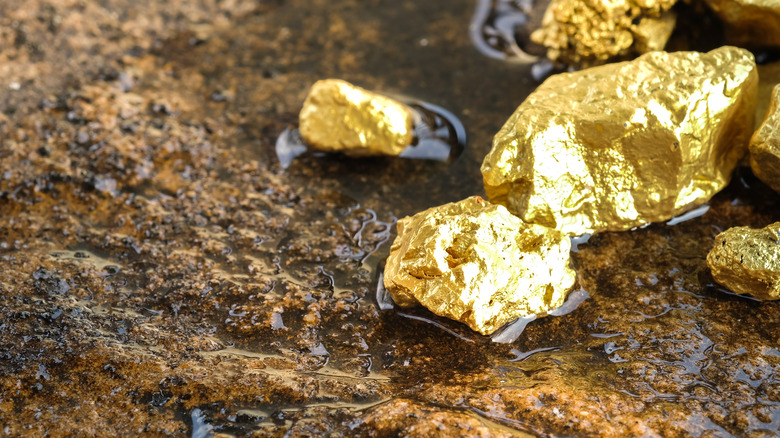The Horrible Truth About Living In The Highest Town In The World
Avid outdoorspeople traverse, hike and climb the most difficult terrain, sometimes at dangerously high altitudes on the tallest peaks, just to catch a glimpse of views only a mountainside could paint on Earth's canvas. Sometimes, they will train for months or even years just to have the strength and stamina to trek up the summit or plan tirelessly to travel across the globe to get there. Meanwhile, other destinations are mere tourist attractions the average hiker or family could travel to and take on.
There are countless famous mountains people flock to, from Grand Teton in Wyoming for its spanning overlooks of Snake River (via Active) to the Andes Mountains in Peru and its Incan hub of Machu Picchu (via Explorer's Passage). While we will be exploring the great Andes Mountains in this article, the view we'll discuss is a bit different than what you're expecting — trading rocky, cloud-blanketed mountainsides for mercury-laden, trash-covered, frigid peaks (via MyBestPlace). It isn't very easy to get to either.
La Rinconada
Hidden within Peru's mystical Andes Mountains (via MyBestPlace) at Mount Ananea's highest peak (via Insider) and sitting at the foot of the permanently frozen La Bella Durmient (aka "Sleeping Beauty") glacier is the town of La Rinconada. "Rinconada," in English, loosely translates to "corner" or "cornered," and here — in one of the most difficult places to live — residents are truly "cornered" in this "corner" of the world; a harsh way of life in exchange for potential riches.
It towers over 3 miles (5,100 meters or 16,732 feet) above sea level (via Departures). The effects of this high altitude — along with frequent sub-freezing temperatures — on the human body are excruciating. Yet, still, nearly 50,000 to 70,000 people chose to live there. And after everything you'll read, you'll wonder why (hint: It's because of something "Au"-inspiring most explorers traveled the world in search of — did you guess it?).
Lack of Infrastructure
For what has become known as the highest inhabited town in the world, La Rinconada lacks much of the infrastructure, vital systems, and public safety initiatives of a functioning town (via MyBestPlace). It does not have any running water or indoor plumbing, waste or sewage disposal, electricity, schools, hospitals, or heating systems (via Sometimes Interesting). The residents of La Rinconada often reject Peruvian governmental involvement or influence, and the living conditions are much lower than Peruvian standards (via Lens Culture).
The area is not much of a tourist destination, nor is it easy to access, so it's no surprise there are no hotels within its bounds (via Insider). Residents stay entertained with a few cafes, bars, and a local soccer team they established. Despite this, all the necessary functions of a town that La Rinconada is lacking result in serious health complications, including decreased quality of life and lifespan.
Health Complications
At an altitude of nearly 17,000 feet, these effects on the body alone are detrimental (via Sometimes Interesting). Your average Joe would usually get hit with the effects of altitude sickness at 10,000 feet, but this community has adapted (via Insider). What they haven't adapted to though is overwhelming pollution and mercury poisoning.
All of their drinking water comes from a nearby lake, which is heavily polluted with mercury, sewage, and waste run-off (via MyBestPlace). Considering people often burn their trash to get rid of it, the air is also polluted with poisons like mercury and cyanide, as is the ground. Surrounding areas, like Lake Titicaca — the largest lake in South America, which is a major source of drinking water — even see shared pollution through run-off from La Rinconada (via The U.S. Sun). Due to all these contributing factors, residents often only live to about 30 to 35 and die from lung diseases and complications as well as damage to the nervous system, which can result in permanent memory loss, paralysis, deformation, skin discoloration, and even death.
Why does anyone live here?
If you "panned" out our "golden" hint from earlier, this won't surprise you: La Rinconada was founded as a mining settlement (equipped for much fewer people) because Mount Ananea (via Insider) is rich with — you guessed it — gold (via MyBestPlace). Gold has been mined in the Andes Mountains for hundreds of years, dating back to Incan civilizations, with modern-day Peru taking eighth place internationally in gold export. And despite frigid temperatures and horrible living conditions, it's what brings new residents to the city to this day.
And it's not just a slow trickle of brave souls who can handle the altitude, pollution, and treacherous climb to work in the mines each day. In fact, the population has skyrocketed by over 230% in the last 10 years (via Sometimes Interesting). But these hopefuls are coming on the dream of glory alone, as nothing is guaranteed, and they are not paid fairly.
Controlled by Crime
When the mines were originally founded, they were operated by a private mining company, which built the town and employed the residents to mine for precious gold (via MyBestPlace). Now, what's known as "Devil's Paradise" is run by gangs, as well as local organizations that do not look kindly to privatized mining companies or the Peruvian government (via Lens Culture). They have developed a payment system called "cachorreo," where miners work for free for 30 straight days, and on the 31st day, they can line their pockets with as much gold as they can carry.
In addition to what is essentially slave labor, miners have been killed in the mines, and women have been trafficked (via The U.S. Sun). According to residents, as the presence of gold in the mountain decreases, violence and heavy consumption of alcohol rise. Women aren't allowed to work in the mines because residents believe it will upset the female spirit of the area. Instead, they sort through ore, which mercury is used to extract gold from. If anyone would want to travel to La Rinconada for the supposed 1 to 2 grams of gold workers say they could take home a week, they would have to embark upon a multi-day trek on a dangerous road to get there. The life they would find there, however, is all the more dangerous.
If you or anyone you know is struggling with addiction issues, help is available. Visit the Substance Abuse and Mental Health Services Administration website or contact SAMHSA's National Helpline at 1-800-662-HELP (4357).
If you or anyone you know has been a victim of sexual assault, help is available. Visit the Rape, Abuse & Incest National Network website or contact RAINN's National Helpline at 1-800-656-HOPE (4673).
